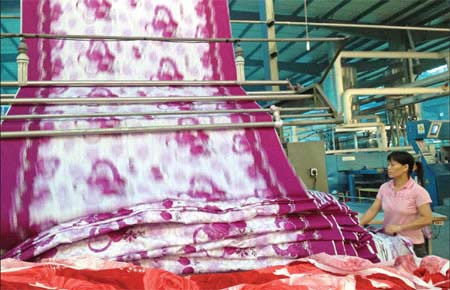
Jishan Dyeing Plant has adopted advanced printing technology to reduce environmental pollution. Yan Yiqi / China Daily
Clothing companies in a county in East China are turning to innovation to beat downward trend in global orders
For Huang Yan this should be the busiest time of the year, when many Chinese companies are usually inundated with Christmas orders from overseas. But one afternoon early this month Huang says she has not received a single sales inquiry all day. The newspapers that lie on her desk have been read twice over and, having forgot to put a book in her bag before leaving home, she hopes she can find some unread dregs on a third reading.
The saleswoman next door is chatting with another one across the hall, and one of the main topics, apart from children and husbands, is how rotten business is at the moment.
Huang is a sales assistant at Zhejiang Weizi Textile, which owns two stores in the East Market of China Textile City, the country's largest market for textile products in Shaoxing county, in Zhejiang province, East China.
Trade has been this slow for several months, she says, and for small factories like the one she works for the problem is acute.
"It should still be Western customers' Christmas buying season, but you can see exactly what it's like."
This one corner of China's largest textile market covering an area of 3.2 million square meters is a microcosm of the business climate in Shaoxing county.
Shaoxing hosts the densest concentration of textile businesses in the country, with more than 1,000 large-scale textile companies generating a total annual turnover of 153.8 billion yuan ($25 billion; 19 billion euros). Textiles account for 64.5 percent of production in Shaoxing, says He Jiashun, the county's Party chief.
"Shaoxing's economy is bound by a piece of cloth. A quarter of the world's textile product trading in terms of quantity is done through China Textile City here."
But He says Shaoxing's booming textile industry has faced many hurdles in its efforts to expand.
In the first three quarters of this year China Textile City sales revenue was 59.3 billion yuan, a 7.5 percent rise year-on-year. Revenue has grown an average of 10 percent in recent years, says Shou Lumin, deputy director of the Construction and Management Committee of China Textile City. From January to September China Textile City's average monthly exports were $255 million (195 million euros), a rise of 7.6 percent year-on-year.
While that performance outshines the meager 0.54 percent growth for textile exports nationally, pressure still weighs heavily on Shaoxing.
"We're not going to say shrinking external demand has had no influence on our member companies this year," Shou says. "On the contrary, we have heard many small companies complain about how difficult business is."
Yu Qi is sales manager at Shaoxing Qingwu Textile, one of the small companies that says it has suffered as orders have fallen. Yu's company's products are sold mainly in economically beleaguered Italy, and she says sales revenue from there has been particularly low since the end of last year. In fact, profits this year may barely be half of what they were last year, she says, refusing to go into details.
"It is not that we don't have orders. In the first half of this year the number of orders from foreign clients grew 15 percent compared with the same time last year. The problem is the prices they offered were too low, so we decided not to take them."
Yu says that if she turns down their orders, that decision may come back to bite the company later on, but if she accepts them, it will hurt the company right now, she says.
"The more orders, the more we lose."
Yu says her company has about 30 workers, and to save costs they are encouraged not to turn up for work three or four days a week.
"Our boss says he will not cut numbers, even though at the moment we really do not need so many workers, but we are afraid that if things improve we will end up being short-staffed."
For bigger companies, shrinking overseas demand may not be as serious a problem as it is for smaller companies, but the former face great pressure to modernize the production chain.
One such company is Zhejiang Jinchan Curtain Co, whose chairman, Yang Lairong, says its biggest problem is not shrinking external demand. In fact, with a history of more than 20 years and more than 700 workers, Yang's company performed well in the first nine months of this year, when sales revenue rose 20 percent year-on-year.
"We have regular customers with whom contracts have been signed long in advance," he says.
Yang says that what preoccupies him most is how to modernize production in this traditionally labor-intensive manufacturing company.
"To be honest, the nature of the textile industry limits the scope of so-called industrial modernization, because the product itself still requires intensive labor and traditional techniques."
Yang says that although his company invested more than 4 million yuan in upgrading the plant last year, many qualified workers are still essential to the production process.
"The cost of hiring highly proficient workers is growing all the time, and we have to look for cutting-edge equipment to reduce those costs. But so far as I know there is no technology in China that can come up with the equipment needed to do away with the intensive production labor that the textiles industry requires."

Copyright ©1999-2011 Chinanews.com. All rights reserved.
Reproduction in whole or in part without permission is prohibited.